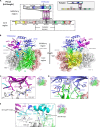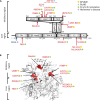The crystal and cryo-EM structures of PLCγ2 reveal dynamic interdomain recognitions in autoinhibition
- PMID: 39612343
- PMCID: PMC11606444
- DOI: 10.1126/sciadv.adn6037
The crystal and cryo-EM structures of PLCγ2 reveal dynamic interdomain recognitions in autoinhibition
Abstract
Phospholipase C gamma 2 (PLCγ2) plays important roles in cell signaling downstream of various membrane receptors. PLCγ2 contains a multidomain inhibitory region critical for its regulation, while it has remained unclear how these domains contribute to PLCγ2 activity modulation. Here we determined three structures of human PLCγ2 in autoinhibited states, which reveal dynamic interactions at the autoinhibition interface, involving the conformational flexibility of the Src homology 3 (SH3) domain in the inhibitory region, and its previously unknown interaction with a carboxyl-terminal helical domain in the core region. We also determined a structure of PLCγ2 bound to the kinase domain of fibroblast growth factor receptor 1 (FGFR1), which demonstrates the recognition of FGFR1 by the nSH2 domain in the inhibitory region of PLCγ2. Our results provide structural insights into PLCγ2 regulation that will facilitate future mechanistic studies to understand the entire activation process.
Figures






References
-
- Koss H., Bunney T. D., Behjati S., Katan M., Dysfunction of phospholipase Cγ in immune disorders and cancer. Trends Biochem. Sci. 39, 603–611 (2014). - PubMed
-
- Zhou Q., Lee G. S., Brady J., Datta S., Katan M., Sheikh A., Martins M. S., Bunney T. D., Santich B. H., Moir S., Kuhns D. B., Priel D. A. L., Ombrello A., Stone D., Ombrello M. J., Khan J., Milner J. D., Kastner D. L., Aksentijevich I., A hypermorphic missense mutation in PLCG2, encoding phospholipase Cγ2, causes a dominantly inherited autoinflammatory disease with immunodeficiency. Am. J. Hum. Genet. 91, 713–720 (2012). - PMC - PubMed
-
- Martín-Nalda A., Fortuny C., Rey L., Bunney T. D., Alsina L., Esteve-Solé A., Bull D., Anton M. C., Basagaña M., Casals F., Deyá A., García-Prat M., Gimeno R., Juan M., Martinez-Banaclocha H., Martinez-Garcia J. J., Mensa-Vilaró A., Rabionet R., Martin-Begue N., Rudilla F., Yagüe J., Estivill X., García-Patos V., Pujol R. M., Soler-Palacín P., Katan M., Pelegrín P., Colobran R., Vicente A., Arostegui J. I., Severe autoinflammatory manifestations and antibody deficiency due to novel hypermorphic PLCG2 mutations. J. Clin. Immunol. 40, 987–1000 (2020). - PMC - PubMed
Publication types
MeSH terms
Substances
LinkOut - more resources
Full Text Sources
Miscellaneous

